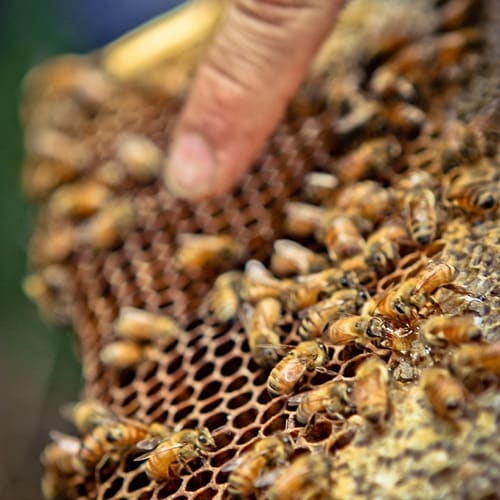Recently I watched Tim Malfroy open and inspect a Warré hive that he installed in Sydney. Over 20 people looked on (it was part of a natural beekeeping workshop) as Tim lifted up boxes, pulled out combs full of honey and brood, and generally checked that all was well in the hive.
What did the bees do during this? Nothing. Nothing at all except keep on buzzing about happily. And that is just unheard of.
I’m beginning to understand just how different Warré beekeeping is. Although I’ve done a course, read some books and blogged about it to boot, it wasn’t until I witnessed just how gentle the bees are in all the Warré hives I’ve seen that i really got this whole Natural Beekeeping thing.
Normally you would expect, when checking a conventionally managed beehive, to be fully protected by your bee suit to avoid the angry clouds of bees who swarm out and try to sting you for opening their hive, yet again.

Tim peels off the hessian blanket that separates the top box from the insulated lid, to have a look inside. Photo by Cathy Xiao Chen

Given that the colony is at 35ºc, there’s quite a bit of heat coming out of the box. Rather calm bees, don’t you think? Photo by Cathy Xiao Chen
But during this inspection, there was none of that. No stings, no angry bees, no belching smoke everywhere to drive the bees off – just gentle, bee-friendly behavior of a beekeeper who, frankly, knows better.
And the bees responded accordingly – they trusted him.
They went about their buzzing business, didn’t sting Tim or anyone else present, and left us all in awe of the complex and beautiful structure of their natural honeycomb and the inner workings of their colony.
Exactly why Warré beekeeping seems to produce such gentle bees (or not produce – more like allows bees to be gentle) is tricky to explain. I had a go at explaining it in The way of the bee: an intro to natural beekeeping but i don’t think i nailed even the half of it. The easiest way to embody it, i think, is to call it bee friendly beekeeping.
Note the fact that the above statement does include the word beekeeping. The Warré technique is not about mirroring a ‘natural’ beehive. It is beekeeping. You are setting up a system that you hope will produce a harvest of honey for you.
However, it is beekeeping done in such a way that disturbance to the bees is minimised, everything is done with the bees best welfare in mind, and the system is designed to keep the bees as happy as they could possibly be, while providing the mechanisms to produce a harvestable quantity of honey.
This last point is where Warré beekeeping differs most from other natural beekeeping techniques. The hive is set up in such a way that, all going well with the season, you should have a box or two (or four!) of pure honey at the top of your hive by autumn.
This means that you are just harvesting surplus honey – you’re not interfering with the colony’s brood comb containing the baby bees, or endangering or upsetting the colony at a time when they are settling down to see the winter through inside their hive.
And of course, you leave enough honey in the hive to see the bees through till spring. Always.
It should be called permaculture beekeeping, if you ask me. Nudging nature to produce a yield, and doing it in a way that ensures a perennial supply.
Many thanks to Belinda for letting our Natural Beekeeping course participants invade your backyard to observe your Warré hive! Big thanks also to Cathy Xiao Chen for the amazing photos.

Belinda holds one of her frames. You can see all the capped honey, some un-capped honey still glistening, and some pollen cells. Photo by Cathy Xiao Chen
Resources:
- Warré Beekeeping info at Biobees.
- Warré beekeeping at Milkwood Farm
- Photoset of the inspection by Cathy Xiao Chen
- Photoset of the inspection by Milkwood
- Urban Bee collective facebook page
- Tim Malfroy’s natural beekeeping page on his website
- Natural Beekeeping courses upcoming…
Watch Milkwood: inside a Warré beehive with Tim Malfroy on YouTube


















Hi! Really interesting post. Can any bee type be used in this method of bee-keeping? I think we mostly have the Cape Bee here. Is this a special bee you are using? Thanks for some super info and pics.
Can someone help me?
My name is Lucian and I am new in the world of bees. I would like some advice from your experience. I bought different things for a warre hive. I would like to know how to stop the bees to swarm, if this is possible. In my country, Romania, are only a few beekeeper that have warre hives. Last year there was a problem with the swarming. Please can you give me some ideas?
Thank you. I am waiting for your advice.
Best wishes
Hi Chelle, I’m sure any of the Apis mellifera bees could be used – although I’d suggest checking if there are already suitable natural hives in your locality. I don’t have any experience with the Cape Bee. Hi Ioan – I’ve heard from my Warré beekeeper friends in France that most of their colonies swarmed last season, so you’re not alone! If the bees want to swarm, they will swarm. But there are some things that can be done to try to prevent it, such as providing plenty of additional space beneath the colony in early spring. If the season… Read more »
Hi, Have you ever used Langstroth hives with foundationless frames? Also, is there a particular reason you have end bars but not bottom bars on your frames?
Thank you.